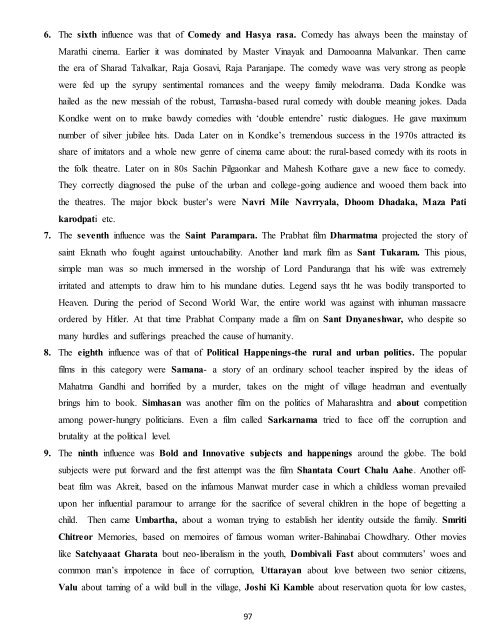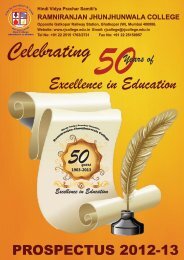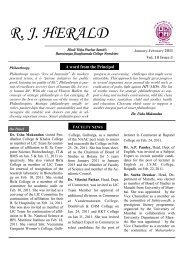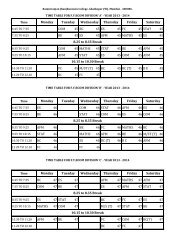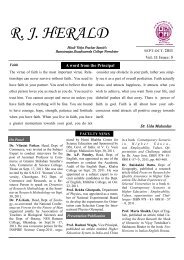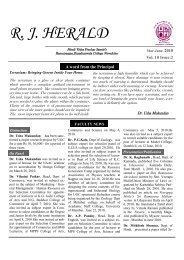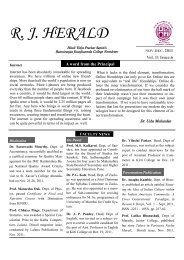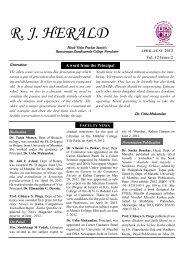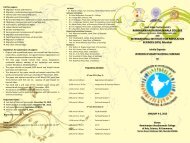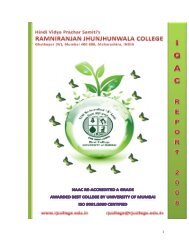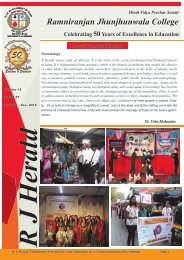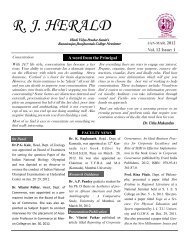ISBN 978-81-925489-2-0 - ramniranjan jhunjhunwala college
ISBN 978-81-925489-2-0 - ramniranjan jhunjhunwala college
ISBN 978-81-925489-2-0 - ramniranjan jhunjhunwala college
Create successful ePaper yourself
Turn your PDF publications into a flip-book with our unique Google optimized e-Paper software.
6. The sixth influence was that of Comedy and Hasya rasa. Comedy has always been the mainstay of<br />
Marathi cinema. Earlier it was dominated by Master Vinayak and Damooanna Malvankar. Then came<br />
the era of Sharad Talvalkar, Raja Gosavi, Raja Paranjape. The comedy wave was very strong as people<br />
were fed up the syrupy sentimental romances and the weepy family melodrama. Dada Kondke was<br />
hailed as the new messiah of the robust, Tamasha-based rural comedy with double meaning jokes. Dada<br />
Kondke went on to make bawdy comedies with ‘double entendre’ rustic dialogues. He gave maximum<br />
number of silver jubilee hits. Dada Later on in Kondke’s tremendous success in the 1970s attracted its<br />
share of imitators and a whole new genre of cinema came about: the rural-based comedy with its roots in<br />
the folk theatre. Later on in 80s Sachin Pilgaonkar and Mahesh Kothare gave a new face to comedy.<br />
They correctly diagnosed the pulse of the urban and <strong>college</strong>-going audience and wooed them back into<br />
the theatres. The major block buster’s were Navri Mile Navrryala, Dhoom Dhadaka, Maza Pati<br />
karodpati etc.<br />
7. The seventh influence was the Saint Parampara. The Prabhat film Dharmatma projected the story of<br />
saint Eknath who fought against untouchability. Another land mark film as Sant Tukaram. This pious,<br />
simple man was so much immersed in the worship of Lord Panduranga that his wife was extremely<br />
irritated and attempts to draw him to his mundane duties. Legend says tht he was bodily transported to<br />
Heaven. During the period of Second World War, the entire world was against with inhuman massacre<br />
ordered by Hitler. At that time Prabhat Company made a film on Sant Dnyaneshwar, who despite so<br />
many hurdles and sufferings preached the cause of humanity.<br />
8. The eighth influence was of that of Political Happenings-the rural and urban politics. The popular<br />
films in this category were Samana- a story of an ordinary school teacher inspired by the ideas of<br />
Mahatma Gandhi and horrified by a murder, takes on the might of village headman and eventually<br />
brings him to book. Simhasan was another film on the politics of Maharashtra and about competition<br />
among power-hungry politicians. Even a film called Sarkarnama tried to face off the corruption and<br />
brutality at the political level.<br />
9. The ninth influence was Bold and Innovative subjects and happenings around the globe. The bold<br />
subjects were put forward and the first attempt was the film Shantata Court Chalu Aahe. Another offbeat<br />
film was Akreit, based on the infamous Manwat murder case in which a childless woman prevailed<br />
upon her influential paramour to arrange for the sacrifice of several children in the hope of begetting a<br />
child. Then came Umbartha, about a woman trying to establish her identity outside the family. Smriti<br />
Chitreor Memories, based on memoires of famous woman writer-Bahinabai Chowdhary. Other movies<br />
like Satchyaaat Gharata bout neo-liberalism in the youth, Dombivali Fast about commuters’ woes and<br />
common man’s impotence in face of corruption, Uttarayan about love between two senior citizens,<br />
Valu about taming of a wild bull in the village, Joshi Ki Kamble about reservation quota for low castes,<br />
97


